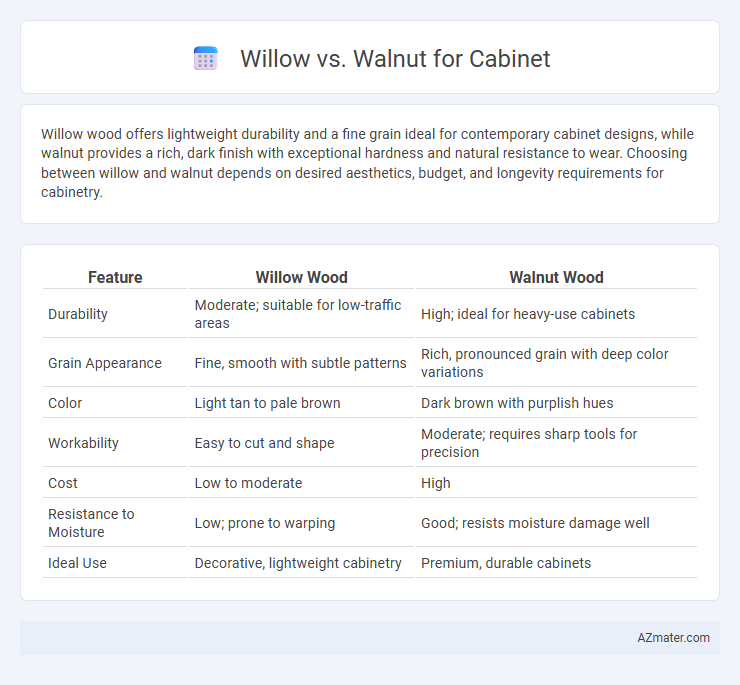Willow wood offers lightweight durability and a fine grain ideal for contemporary cabinet designs, while walnut provides a rich, dark finish with exceptional hardness and natural resistance to wear. Choosing between willow and walnut depends on desired aesthetics, budget, and longevity requirements for cabinetry.
Table of Comparison
| Feature | Willow Wood | Walnut Wood |
|---|---|---|
| Durability | Moderate; suitable for low-traffic areas | High; ideal for heavy-use cabinets |
| Grain Appearance | Fine, smooth with subtle patterns | Rich, pronounced grain with deep color variations |
| Color | Light tan to pale brown | Dark brown with purplish hues |
| Workability | Easy to cut and shape | Moderate; requires sharp tools for precision |
| Cost | Low to moderate | High |
| Resistance to Moisture | Low; prone to warping | Good; resists moisture damage well |
| Ideal Use | Decorative, lightweight cabinetry | Premium, durable cabinets |
Introduction to Willow and Walnut Cabinets
Willow cabinets, known for their light, warm tones and smooth grain, offer a soft, natural aesthetic ideal for contemporary and rustic kitchen designs. Walnut cabinets stand out with rich, deep brown hues and striking grain patterns, providing a luxurious and classic feel favored in traditional and modern interiors. Both materials are durable, with walnut generally denser and more resistant to wear compared to the lighter, more porous willow wood.
Aesthetic Differences: Willow vs Walnut
Willow cabinets offer a light, airy aesthetic with a subtle grain pattern that complements rustic, coastal, or farmhouse styles. Walnut features rich, deep brown tones with pronounced grain variations, creating a luxurious and elegant look ideal for traditional or contemporary interiors. The warm, natural hues of walnut provide a striking contrast to the softer, muted appearance of willow, making each wood distinctly suited to specific design preferences.
Wood Grain and Texture Comparison
Willow wood features a smooth, fine grain with subtle, wavy patterns that create an elegant and uniform texture ideal for contemporary cabinets. Walnut exhibits a rich, pronounced grain with varied swirls and knots, offering a bold and natural character often sought after for traditional or rustic cabinetry. The difference in texture makes willow suitable for sleek finishes, while walnut provides depth and visual complexity in wood cabinetry.
Durability and Longevity
Walnut cabinets are renowned for their exceptional durability and long lifespan, thanks to their dense hardwood composition that resists dents and scratches. Willow wood, while aesthetically appealing with its unique grain patterns, is softer and less resistant to wear, making it less ideal for high-traffic cabinetry. For kitchens and bathrooms requiring robust, long-lasting cabinets, walnut provides superior longevity and resilience.
Color and Finish Options
Willow wood cabinets offer a lighter, creamy beige hue with subtle grain patterns, providing a soft, natural aesthetic ideal for contemporary and Scandinavian designs. Walnut cabinets present a rich, deep brown color with warm undertones and intricate grain details, enhancing traditional and luxury interiors with their elegant finish. Both woods accept stains and finishes well, but walnut typically showcases a more durable, polished sheen that highlights its darker color depth.
Maintenance and Care Requirements
Willow cabinets demand minimal maintenance due to their natural resistance to moisture and easy-to-clean surface, making them ideal for busy kitchens. Walnut requires regular oiling or polishing to maintain its rich color and prevent drying or cracking, especially in humid environments. Both woods benefit from avoiding harsh chemicals and direct sunlight to prolong their durability and aesthetic appeal.
Cost Analysis: Willow Cabinet vs Walnut Cabinet
Willow cabinets typically cost less than walnut cabinets due to the faster growth rate and greater availability of willow wood, making them a budget-friendly option for kitchen remodeling. Walnut cabinets, known for their rich color and durability, command higher prices, often reflecting the cost of premium hardwood and intricate grain patterns. Choosing between willow and walnut depends on balancing initial investment with desired aesthetic and long-term value in cabinetry.
Environmental Impact and Sustainability
Willow cabinets offer a lower environmental impact due to their rapid growth rate and renewable harvesting practices, making them a sustainable choice compared to walnut. Walnut trees have a slower growth cycle and are often harvested from older forests, which raises concerns about deforestation and habitat loss. Choosing willow supports eco-friendly forestry management and reduces carbon footprint in cabinet production.
Popular Design Styles for Willow and Walnut Cabinets
Willow cabinets are popular in rustic, farmhouse, and country-style designs due to their warm, light tones and prominent grain patterns, which enhance cozy and natural interiors. Walnut cabinets, known for their rich, dark brown hues and smooth grains, fit seamlessly into modern, mid-century, and contemporary kitchen styles, adding elegance and sophistication. Both woods offer distinct aesthetic qualities, making willow ideal for casual, inviting spaces, while walnut suits sleek, high-end environments.
Choosing the Right Wood for Your Cabinet Needs
Willow offers a lightweight, flexible option with a smooth grain, ideal for contemporary cabinets requiring ease of customization and a warm, natural look. Walnut provides a dense, durable hardwood with a rich, dark color and striking grain patterns, perfect for high-end cabinetry demanding longevity and a luxurious finish. Choosing between willow and walnut hinges on balancing budget, desired aesthetic, and durability requirements for your cabinetry project.

Infographic: Willow vs Walnut for Cabinet
 azmater.com
azmater.com